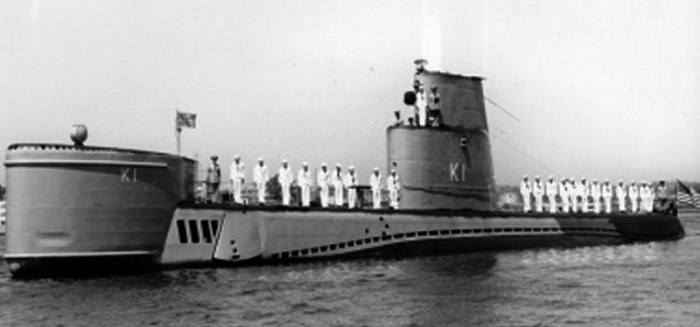
 US Navy Attack Submarines (SSK) 1951-1974
US Navy Attack Submarines (SSK) 1951-1974Cold War US Subs
GUPPY | Barracuda class | Tang class | USS Darter | T1 class | X1 class | USS Albacore | Barbel classUSS Nautilus | USS Seawolf | Migraine class | Sailfish class | Triton class | Skate class | USS Tullibee | Skipjack class | Permit class | Sturgeon class | Los Angeles class | Seawolf class | Virginia class
Fleet Snorkel SSGs | Grayback class | USS Halibut | Georges Washington class | Ethan Allen class | Lafayette class | James Madison class | Benjamin Franklin class | Ohio class | Colombia class
Third entry into the cold war USN submarine tree, after the GUPPY class and USS Nautilus, here is the Barracuda class SSK (diesel-electric attack submarines). This was the first class of conventionally-powered subs after the end of WW2, an attempt not only to make a clear departure from WW2 designs, but do swap onto the new trend inaugurated by the revolutionary WW2 Type XXI U-Boats, of which the USN obtained U-2513 as war reparation, throroughly tested. This first generation of post-war “submarines” (no longer “submersibles” due to new underwater speed and range), was developed alongside the GUPPY upgrade for the Gato/Tench/Balao or “fleet snorkel”. It concerned only three boats (USS Barracuda, Bass, Bonita) laid down in 1949 and completed in 1952, as prototypes for a small, cheap and mass-produced “ambushers” for Soviets subs leaving their bases… #coldwar #usnavy #submarines #barracudaclass #kclasssubmarines
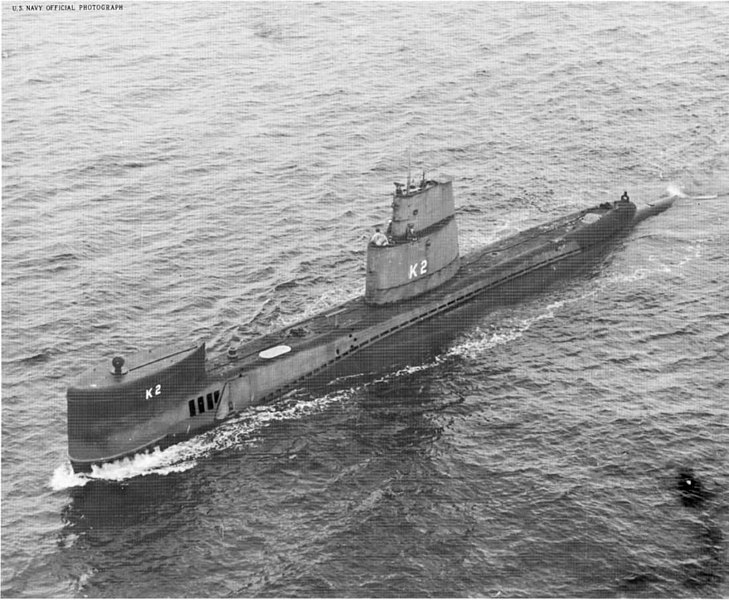
Genesis: The Type XXI influence
This point has been well developed already in the Type XXI post itself, and also in the GUPPY conversion genesis. So to make it succint, just let’s states that a complete report has been written about it. But the SSK type was designed as a simplified type (Project Kayo) not to integrate all these niceties.
The U-2513 tests
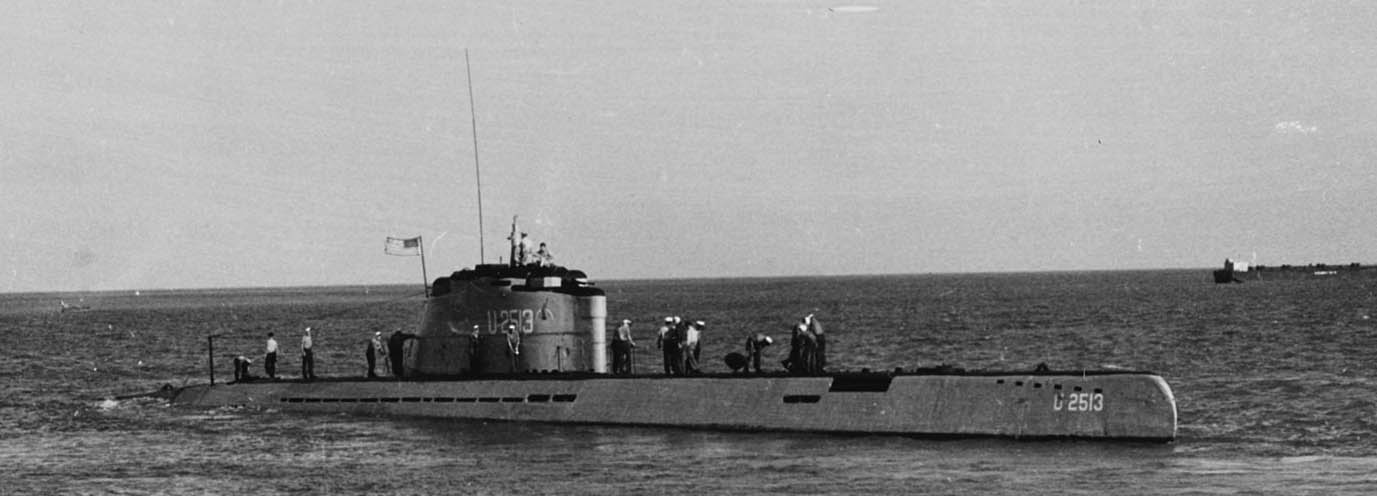
U-2513 off Key West tested by the US Commission
A classified report was written and sent to the CNO in July 1946 about the U-2513 allotted by treaty. Previously commissioned under captain Erich Topp (U-Boat ace) she was still training at V-Day. The first tests revealed how susprised was the crew of her top speed while submerged during sea trials achieved on electric power alone. She notably could sprint at 16 knots for about one hour, which could have left plenty of time in evasive manoeuvers to left behind most destroyer escorts of the time. Her longer underwater autonomy (however limited by her speed tests) was also impressive and way above all US designs of the time. And there was her snorkel, enabling her to cruise long distances with diesels running while submerged until aircraft was in patrol nearby. It even made possible to plug one diesel to charge the batteries, while the other ran the boat while submerged. On paper she was able to be underwater practically all the way from port to mission point and back.
The team marvelled also at the periscope optics and passive sonar they estimated much superior to USN standards, as well as the ingenious hydraulically operated torpedo-handling gear for a full reload in five minutes on button push. In drydock, engineers measured with astonishment the thickness and strength of her pressure hull, evaluating much greater depth (another survival trick) than US standard, estimated with a crushing point as low as 1,500 feet, with a practical limit at 1,200, twice a Gato safe depth limit. U-2513 “automatic pilot” for precise depth-keeping at high speeds was also noted.
However the commission noted also far less stellar aspects of the design: Numerous, sometimes grave manufacturing faults, poor structural integrity with crudely made modules, barely fitting together properly, weak diesel engines due to faulty superchargers, degraded real surface speed, unreliable hydraulic system, too complex and delicate as well as saltwater leakage and corrosion, plus faulty Snorkel which gushed water in north atlantic usual weather. But still, the results percolated in US Submarine design doctrine and made their way gradually into a whole line of upgrades, the GUPPY I, II, III and sub-variants in between, which enabled to present to the new soviet threat, most of the still extant WW2 sub fleet, duly upgraded, at a lower cost than creating a new class.
The Soviet sub threat
whiskey class
It took years to the US Navy to modernize the Gato/Tench/Balao, the famous “fleet snorkels” of the 1950s, but still there was the need to at least test a new class, a new conventional attack submarine to be develop, at least in small series of near-prototypes to test the waters of these new concepts. The USSR did wasted time on its side and after obtaining several Type XXIs, as well as paperwork and plans, even snatching out some naval engineers during operation Osoaviakhim, as Staling wanted to right away grand plans for its navy and their own mass-produced version of the Type XXI. This became the ambitious Type 613 Project, known by NATO as the “Whiskey” class attack submarines. Not only they faithfully reproduced and reintepreted the Type XII, earning similar capabilities but less all the automation and technological shenanigans which went with it. The Project 613 boats in total were produced from 1951 to 1958 with an astonishing total of 215 boats, as much as WW2 US sub fleet. They were all poised to seriosuly disrupt the Atlantic trade lines, and thus, became immediately a major concern for NATO in the 1950-60s.
The US admiralty board came with several proposals to deal with the matter:
-Convert as many ww2 legacy Gato/Tench/Balao boats as possible, to have the numbers quickly anch cheaply
-Test a new type of conventional attack submarine, classic with long range to hunt down opposite ‘Whidkeys’
-Test nuclear propulsion for submarines (at first only by Rickover from 1949)
-An interim “ambush type” design to proceed to a station and stay there, mass-produced.
The GUPPY program was the easier to “sell” to the congress in these budget-strapped postwar years and thus, easier to fund and start, in 1949. As for the “Type XXI-clone”, conform to US standard and yet with all the innovations and less the issues of the type, to answer the Whiskey class with a more definitive type, its development took time. USS Tang (SS 563) was the first laid down in 1949, and six were built until 1952. At 2,260 tons and 82 m long they were a bit smaller than their WW2 counterparts, but were also less crew-intensive. They will be seen next. There was also the nuclear option. To be fair, it was seen seriously only for fleet escort, as none could guess a nuclear reactor, of feasible, would be small enough to be crammed into a submarine. This was to be on fleet escorts only, either cruisers or destroyers, to protect precious task forces. It’s only the unrelentless drive of Hyman Rickover, mainly at first against navy top brass, that would ultimately led to the construction from 1952 of USS Nautilus, completely changing the way submarines would be propelled.
Genesis of the SST; Project Kayo
pic
It was known that the Soviet Navy had acquired the German Type XXI and XXIII U-boats and plans, and so was believed to copy them rapidly. In 1948 the US Navy estimate a number of SSKs to be available to the Soviet Navy in 1960, having a “reasonable” scenario in which the Soviets would have at that stage some 360 submarines, and the worst one, projecting the same level of commitments as the Germans with an even greater emphasis on cruder, more massive production even, producing a force below 2,000 submarines. It was compared to the US best possible production of 250 with an average in 1960 of 970 for the Soviets, excluding those of WW2, which were mostly still in service, and perhaps 200. Thus, instead of embarking on a very complex model, embrassing and improving on all the niceties of the best German design, an “expandable” type was envisioned as a stopgap. In case of war they would be built by the hundreds in various yards, something even superior to the WW2 effort, whle being clever in the tactics.
So came Project Kayo, the solution of a “cheap, small and dirty” type of unrefined conventional hunter-killer submarine that could be ideal for mass production in case of war. Most of the innovations of the Type XXI were left for the Tang class, and for SST 3, the first of these prototypes, the Navy wanted something closer to the German Type XXIII, itself a dumbed-down mass produced Type XXI. Exit the automation and fancy systems, this new model would be limited to what worked, the essentials. From this, BuShips prepared a draft for the admiralty board, and queried the great historical pioneer, Electric Boat, for the initial prototype. This research and development effort started in 1946 based on many reports of sub-on-sub encounters and was initially targeting to create a submarine type to attack and destroy enemy submarines. They originally had the hull classification symbol SSK, for “hunter-killer submarine”. This became synomnimous with conventional attack submarine later.
Design of the Barracuda (“K-class”)

These three small diesel submarines were intended as prototypes of a mass produced ASW submarines which would ambush enemy submarines as they emerged from their bases. The principal requirements were quietness, low cost and an effective passive sonar, the latter being carried in an enlarged bow sonar dome. They were soon criticised as too small for habitability for sea keeping and USS Tullibee latter was an attempt to update the ASW submarine (SSK) concept. In view of limited resources available for new construction during the early postwar period, an SSK conversion of fleet submarines was developed as a mobilisation measure (The GUPPY programme) designed to permit later modification to SSK standard.
The Barracuda-class SSKs were much smaller, simpler in design and construction that the previous WW2 Gato class. Mass-production was at the heart of the concept destined to shipyards without submarine experience, or eve, aircraft contractors experienced with mass production of large and complex aircraft (like the B-29). The USN looked at the bunkerized mass-production factories designed by Speer and engineers in 1944 and modularilty to built the Type XXI and XIII at an impressive daily rate. Limitations in Germany in materials, workforce and under constant bombardment never provided a suitable environment for these ideas to flourish but in the postwar US it was another matter…
The primary innovation of the design however in Project Kayo was its low-frequency passive bow sonar system BQR-4. This was something completely new. Rather than “pinging” other subs with a powerful emission, the idea was simply to listen, but on a more acute and proactive way. The sonar was originally to be wrapped around the conning tower but testing on USS Grampus, a Tench class GUPPY converted, showed that disturbances around the CT would create its own noise, covering the detection range. So it was relocated to the bow, which became the go-to solution for all navies. Due to this large sonar dome, built just above the torpedo tubes, the latter remained in their traditional position, albeit lower.
Hull and general design
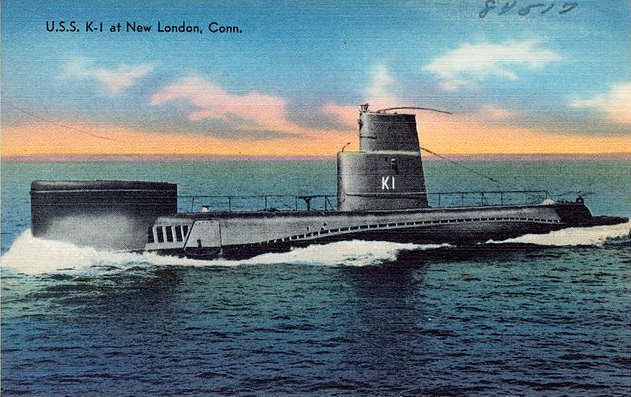
These boats were light to some extent, displacing 765 tons (777 t) surfaced, up to 1,160 tons (1179 t) submerged, showing a great buoyancy reserve. The hull was short and “stubby”, with a length of 196 ft 1 in (59.77 m) overall, for a beam of 24 ft 7 in (7.49 m), so a ratio of 8. The draft was reduced to 14 ft 5 in (4.39 m) mean, to allow them coasting and staying in shallow waters close to harbours. Design wise, the hull was less streamlined than the Type XXI/XIII, still with the flat deck all long, dying before the traditional end and tail with rudder and two horizontal planes, just like any WW2 boats.
The forward section was also classic in shape, ending with a prow, and of course the massive sonar dome that was expected to create disturbances. The conning tower was shaped like the second generation Guppy boats, with a two-part structure, lower for deck observaiton under a plexiglas dome and highier with a second open observation deck and periscopes suite (radar, sensors, and two types plus simplified snorkel). The hull also had two counterkeels. Facilities were inline with WW2 accomodations, but even crampier, designed for 37 officers and men.
Powerplant and performances
These subs had three General Motors 8-268A diesel engines for a total of 1,220 shp and 184 tons of diesel oil. These were complemented with two General Electric electric motors with just one 126-cell battery (1,050 shp), a power passed on two shafts. This certainly was not what was required for conventional sub operations against Soviet surface ships and trade lines. This was not their goal. Compared to a Gato class, the main power was weak, since the latter were capable of 5,400 shp (4.0 MW) surfaced and 2,740 shp (2.04 MW) submerged for electrical power based on 2× 126-cell batteries.
As for performances, top speed surface was not impressive, at just 13 knots (24 km/h) and 8.5 knots (15.7 km/h) underwater. Again, they were not designed for active warfare, but rather than as stationary “ambush boats”, so what was more important was range, and for this, they reach 9,000 nautical miles (17,000 km) despite their small size, which was more impressive. The weak point was certaoinly the crew’s resistance and food supply for long deployments. The hull was also more strongly built, enabling to dive deeper than WW2 models, with a test depth of 400 ft (120 m) and crush depht well below that point, around 150 m.
Armament
Being that small, these boats had limited armament, with just four 21 inch (533 mm) Mark 47 torpedo tubes at the bow. They fired a single type, which by 1950 was the Mark 16 (Mod 3) which weighted 4,000 lb (1,800 kg), carried a 746 lb (338 kg) Torpex or HBX (later used HBX-3) 960 lb (440 kg) Torpex (later used HBX) warhead, and turbine to reach 13,700 yd (12,500 m). This was the base unguided model in service until 1975, but either of the Mark 18, 20, 22, 23, 26, 28, 29 models. The more modern would have been the Mark 33 Mod 0 measuring 6.9 ft (2.1 m) for 1,795 lb (814 kg) and carrying a 550 lb (250 kg) warhead, HBX, Electric-powered for quietness, with either 12.5 knot (23.2 km/h) setting at 19,000 yd (17,000 m) or 18.5 kn (34.3 km/h) at 5,000 yd (4,600 m), the perfect match for their role. They carried only four reloads.
Sensors
BPS-12 radar: The AN/BPS-12 is a medium-range pulse-only surface search and navigation radar on preriscope mast. The BPS-12 is a modified BPS-5, similar to the BPS-14. Max range 74.1 km.
BQR-3 Sonar: Early type of passive cheap sonar, also shared by the GUPPY type. No more info yet
BQR-4 sonar: Conformal passive array predecessor to the BQR-7 on Permit/Sturgeon class, an evolution added during upgrades, same type with more range.

⚙ Barracuda class specifications |
|
| Displacement | 765 tons (777 t) surf/ 1,160 tons (1179 t) submerged |
| Dimensions | 196 ft 1 in x 24 ft 7 in x 14 ft 5 in (59.77 x 7.49 x 4.39 m) |
| Propulsion | 2 shafts, 3x GM 8-268A diesels 1220/1,050 shp (780 kW), 2x GE EM 1x 126 cell bat. |
| Speed | 13 knots (24 km/h) surfaced, 8.5 knots (15.7 km/h) submerged |
| Range | 9,000 nautical miles (17,000 km), test depth 400 ft (120 m) |
| Armament | 4× 21 in (533 mm) Mk 47 TTs bow, 8 torps. |
| Sensors | BPS-12 radar, BQR-3, BQR-4 sonars |
| Crew | 37 officers and men |
The Barracuda class in action
When the boat was rigged for silent running, their sonar arrays gave a very lare convergence zone detection ranges against snorkeling submarines. But if theyr had excellent ears, they were marred by a weak punch between, limited armament and performances. As all SSKs they also needed to snorkel periodically. Thei main merit remains in Project Kayo behinf them, pioneering groundbreaking sonar technology invaluable to later nuclear-powered submarines. They would remained unloved mobilization prototypes with a limited use in peacetime but to demonstrate a concept and validate a potential wartime model.
USS Barracuda was stricken on 1 October 1973, re-classified formally as an attack submarine on 1 August 1972. All three had their large bow arrays removed in 1959, renamed with ‘B’ names in December 1955, and in 1959 withdrawn from the SSK role. Barracuda became the training submarine T 1 (SST 3), her sisters the attack submarine SS 550 and SS 551. They were both stricken in April 1965, Bonita was spent as target.
 USS K-1 (SSK-1) Barracuda (1951)
USS K-1 (SSK-1) Barracuda (1951)

USS Barracuda joined Submarine Development Group 2 stationed at home port New London, Connecticut. She cruised along the Atlantic froml the Carribean to Newfoundland, making a transoceanic cruise one to voyage to Greenock and Rothesay in Scotland by June 1955 to demonstrate the capability to be deployed in Europe and from there, gained their respective operating areas. On 15 December 1955 her name was changed from K-1 to Barracuda (SSK-1) as said above, and between cruises and eastern seaboard operation she trained with ships and were used for and experimental exercises.
In 1958, the Soviet threat to nuclear-powered so the planned SSK force looked obsolete. She was withdrawn, redesignated SST-3 on 15 July 1959. She was homeported to Charleston in South Carolina and later to Key West in Florida. Overhauled from 1963 to 1964 at Norfolk she was getting rid of her large sonar array, replaced with a streamlined bow ad reverted to GUPPY configuration. By 1968 she was transferred back to Charleston as training boat for junior officers and ratings and by 1 August 1972, redesignated again SS-T3 with hull number SS-550 (never official). She was was decommissioned on 1 October 1973 at Charleston, stricken, then scrapped 8 April-8 July 1974 near Charleston.
 USS K-2 (SSK-2) Bass (1951)
USS K-2 (SSK-2) Bass (1951)

K-2, one of two Mare Island Naval Shipyard boats, was laid down on 23 February 1950, launched on 2 May 1951 and commissioned on 16 November 1951, posted to Pearl Harbor on 23 May 1952 to join Submarine Division 72. She started a special evaluation program to assess all her capabilities and limitations. In January 1953 she was in restricted availability for completing her equipment. In June 1953 she returned to fleet training and to develop new tactics, coordinated operations the fleet.
In January 1955, she had an overhaul at Mare Island Naval Shipyard and resume exercizes, cruising to Mazatlán, Mexico, and back to Pearl Harbor. Renamed USS Bass on 15 December 1955 she remained in the Pacifc Fleet Hawaii until June 1957. On 26 June 1957 she was back home, sent to operate from the West Coast until decommissioned on 1 October 1957. Hull classification became SS-551 on 15 August 1959. She stayed in limited use and was stricken from the Register in 1965, sold for scrap on 17 November 1966. A short career indeed.
 USS K-3 (SSK-3) Bonita (1951)
USS K-3 (SSK-3) Bonita (1951)
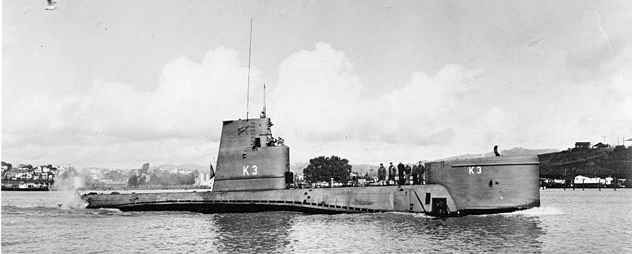
K3 was built at Mare Island Naval Shipyard as her suster K2, laid down on 19 May 1950, launched 21 June 1951 and commissioned on 11 January 1952. She joined Submarine Squadron 7 at Pearl Harbor, on 15 May 1952 for experimental tests and develop ASW tactics linked to her new sonar type. In February 1955 was overhauled at Pearl Harbor Naval Shipyard until September. Renamed Bonita on 15 December 1955 she cruised to Alaskan waters (Aleutians) to test the class an sonar behavious in cold and icy waters, betwen August and September 1956. By June 1957 she was reassigned to Submarine Squadron 5 homeported to San Diego in California and limited from there to ASW training duties. In October she was overhauled at San Francisco Naval Shipyard, with the removal of the sonar, and installation of new electronics, and reporting back to HP San Diego in January 1958.
In April–June 1958 she was used as a nuclear weapons testing target, sent to Eniwetok, taking part to Operation Hardtack I. But instead she was reassigned as testboat for shock trials with new types of depht charges, rather than pure destructive testing. As aresult only damage to her electronics were reported. She was decommissioned on 7 November 1958, being just given the hull number SS-552 in August 1959, stricken on 1 April 1965, sold for scrap on 17 November 1966.
Read More/Src
Books
Friedman, Norman (1994). U.S. Submarines Since 1945: An Illustrated Design History. NIPwbr>
Bauer, K. Jack; Roberts, Stephen S. (1991), Register of Ships of the U.S. Navy, 1775-1990 Greenwood Press
Gardiner, Robert and Chumbley, Stephen, Conway’s All the World’s Fighting Ships 1947–1995, Conway Maritime Press
Links
guppysubmarinetribute.homestead.com
navypedia.org
wwiiafterwwii
navsource.org
history.navy.mil
wikipedia.org

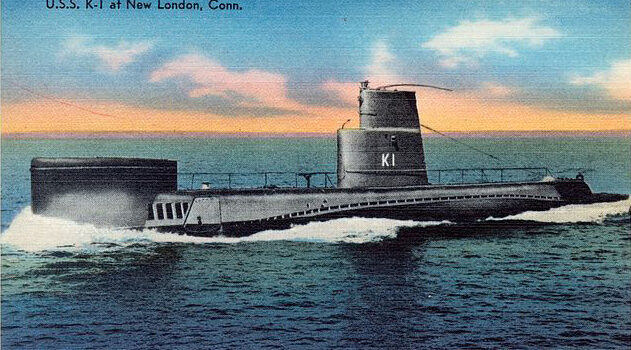
 Latest Facebook Entry -
Latest Facebook Entry -  X(Tweeter) Naval Encyclopedia's deck archive
X(Tweeter) Naval Encyclopedia's deck archive Instagram (@navalencyc)
Instagram (@navalencyc)





 French Navy
French Navy Royal Navy
Royal Navy Russian Navy
Russian Navy Armada Espanola
Armada Espanola Austrian Navy
Austrian Navy K.u.K. Kriegsmarine
K.u.K. Kriegsmarine Dansk Marine
Dansk Marine Nautiko Hellenon
Nautiko Hellenon Koninklije Marine 1870
Koninklije Marine 1870 Marinha do Brasil
Marinha do Brasil Osmanlı Donanması
Osmanlı Donanması Marina Do Peru
Marina Do Peru Marinha do Portugal
Marinha do Portugal Regia Marina 1870
Regia Marina 1870 Nihhon Kaigun 1870
Nihhon Kaigun 1870 Preußische Marine 1870
Preußische Marine 1870 Russkiy Flot 1870
Russkiy Flot 1870 Svenska marinen
Svenska marinen Søværnet
Søværnet Union Navy
Union Navy Confederate Navy
Confederate Navy Armada de Argentina
Armada de Argentina Imperial Chinese Navy
Imperial Chinese Navy Marinha do Portugal
Marinha do Portugal Mexico
Mexico Kaiserliche Marine
Kaiserliche Marine 1898 US Navy
1898 US Navy Sovietskiy Flot
Sovietskiy Flot Royal Canadian Navy
Royal Canadian Navy Royal Australian Navy
Royal Australian Navy RNZN Fleet
RNZN Fleet Chinese Navy 1937
Chinese Navy 1937 Kriegsmarine
Kriegsmarine Chilean Navy
Chilean Navy Danish Navy
Danish Navy Finnish Navy
Finnish Navy Hellenic Navy
Hellenic Navy Polish Navy
Polish Navy Romanian Navy
Romanian Navy Turkish Navy
Turkish Navy Royal Yugoslav Navy
Royal Yugoslav Navy Royal Thai Navy
Royal Thai Navy Minor Navies
Minor Navies Albania
Albania Austria
Austria Belgium
Belgium Columbia
Columbia Costa Rica
Costa Rica Cuba
Cuba Czechoslovakia
Czechoslovakia Dominican Republic
Dominican Republic Haiti
Haiti Hungary
Hungary Honduras
Honduras Estonia
Estonia Iceland
Iceland Eire
Eire Equador
Equador Iran
Iran Iraq
Iraq Latvia
Latvia Liberia
Liberia Lithuania
Lithuania Mandchukuo
Mandchukuo Morocco
Morocco Nicaragua
Nicaragua Persia
Persia San Salvador
San Salvador Sarawak
Sarawak Uruguay
Uruguay Venezuela
Venezuela Zanzibar
Zanzibar Warsaw Pact Navies
Warsaw Pact Navies Bulgaria
Bulgaria Hungary
Hungary

 Bundesmarine
Bundesmarine Dutch Navy
Dutch Navy Hellenic Navy
Hellenic Navy Marina Militare
Marina Militare Yugoslav Navy
Yugoslav Navy Chinese Navy
Chinese Navy Indian Navy
Indian Navy Indonesian Navy
Indonesian Navy JMSDF
JMSDF North Korean Navy
North Korean Navy Pakistani Navy
Pakistani Navy Philippines Navy
Philippines Navy ROKN
ROKN Rep. of Singapore Navy
Rep. of Singapore Navy Taiwanese Navy
Taiwanese Navy IDF Navy
IDF Navy Saudi Navy
Saudi Navy Royal New Zealand Navy
Royal New Zealand Navy Egyptian Navy
Egyptian Navy South African Navy
South African Navy






























 Ukrainian Navy
Ukrainian Navy dbodesign
dbodesign